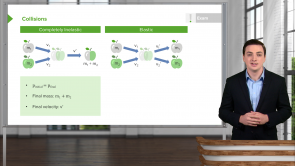Elastic Collision: Example

About the Lecture
The lecture Elastic Collision: Example by Jared Rovny, PhD is from the course Momentum.
Included Quiz Questions
Two masses m₁ = 10 kg and m₂ = 2 kg collide head on elastically. Before collision m₁ was traveling with velocity of 2 m/s to the right and m₂ was traveling with velocity of 4 m/s to the left. What are the final velocities of both objects after collision?
- v₁ : 0 m/s , v₂ : 6 m/s to the right
- v₁ : 2 m/s to the right , v₂ : 6 m/s to the right
- v₁ : 1 m/s to the right and v₂ : 5 m/s to the right
- v₁ : 1 m/s to the left , v₂ : 2 m/s to the left
- v₁ : 0.5 m/s to the right , v₂ : 3 m/s to the right
A 10 kg block moving with initial velocity of 2 m/s collides with a 6 kg wooden block moving towards the first block with velocity -4 m/s. After collision the wooden block comes to rest. What is the final velocity of the 10 kg block ? Is this collision an elastic collision ?
- -0.4 m/s, collision is an inelastic collision since total kinetic energy is not conserved
- -1.4 m/s, collision is an inelastic collision since total kinetic energy is not conserved
- 0 m/s, collision is an inelastic collision since total kinetic energy is not conserved
- -4 m/s, collision is an elastic collision
- 1.4 m/s, collision is an elastic collision
An object of mass 4.0 kg and velocity of 2.0 m/s collides elastically with an object of mass 6.0 kg that has a velocity of -4.0 m/s. What are the velocities of the objects after the collision?
- -5.2 m/s and 0.8 m/s respectively
- -5.2 m/s and 8 m/s respectively
- -8 m/s and 4m/s respectively
- -0.8 m/s and 5.2 m/s respectively
- -0.8 m/s and -5.2 m/s respectively
What happens if a light object collides with a much heavier target which is at rest ?
- The light object bounces off the target, maintaining the same speed but with opposite direction. The heavy target remains at rest.
- The light object comes to rest after hitting the target. The heavy target moves with less speed as compared to the light objects speed before collision.
- The light object bounces off the target, with increased speed but with opposite direction. The heavy target remains at rest.
- The light object bounces off the target, with less speed but with opposite direction. The heavy target remains at rest.
- The light object bounces off the target, with less speed but with opposite direction. The heavy target moves with same initial velocity of light object.
A badminton player serves a shuttle. The speed of her racket is measured by high speed camera at vᵣ = 20 m/s just prior to striking the shuttle. What would be the approximate speed of the shuttle after the collision?
- Speed of the shuttle will be double the speed of the racket because the mass of the racket is much larger than the shuttle
- Speed of the shuttle will be the same as the racket speed after collision
- Speed of the shuttle will be a quarter of the speed of the racket because the mass of the racket and the serving force is smaller
- Speed of the shuttle will be half of the speed of the racket because the mass of the racket is lower than the shuttle
- Speed of the shuttle will be four times the speed of the racket because the mass of the racket is much larger than the shuttle and the serving force is very large
Customer reviews
5,0 of 5 stars
| 5 Stars |
|
5 |
| 4 Stars |
|
0 |
| 3 Stars |
|
0 |
| 2 Stars |
|
0 |
| 1 Star |
|
0 |





